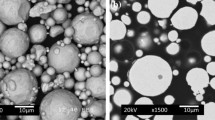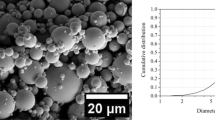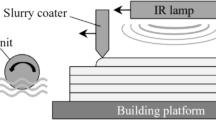Abstract
Binder jet 3D printing combined with post-deposition sintering is a non-beam additive manufacturing (AM) method for the creation of complex 3-dimensional structures. Binder saturation and particle morphology are two important factors affecting the quality of printed parts. Here, we investigated the effects of binder saturation on dimension accuracy, porosity, microstructure, and microhardness of nickel-based alloy 625 samples made of differently atomized powders. Argon gas atomized (GA) and water atomized (WA) nickel-based alloy 625 powders were used to binder jet samples for a detailed comparative study. The optimal binder saturation for WA system is 60 to 70%, whereas for GA system the optimal is about 80%. Generally, GA samples achieved better overall quality than WA samples in terms of packing density, dimensional accuracy, sintered density, and microhardness. This difference is attributed mainly to the particle morphology including sphericity and roundness. The critical threshold for visible binder bleeding phenomenon in WA and GA systems is determined to be 120% and 140% binder saturation, respectively. Mechanisms for binder bleeding phenomenon at different saturation levels for WA and GA systems are discussed in detail. A pore evolution model is proposed to better understand the printing and sintering processes.











Similar content being viewed by others
Data availability
Raw data may be requested from the corresponding author.
References
Mostafaei A, Toman J, Stevens EL, Hughes ET, Krimer YL, Chmielus M (2017) Acta Materialia Microstructural evolution and mechanical properties of differently heat-treated binder jet printed samples from gas- and water-atomized alloy 625 powders. Acta Mater 124:280–289. https://doi.org/10.1016/j.actamat.2016.11.021
Chyrkin A, Bo C, Barnikel J, Schmitz F, Quadakkers WJ (2014) Oxidation behaviour and microstructural stability of alloy 625 during long-term exposure in steam:6127–6142. https://doi.org/10.1007/s10853-014-8344-7
Mostafaei A, Behnamian Y, Krimer YL, Stevens EL, Li J, Chmielus M (2016) Effect of solutionizing and aging on the microstructure and mechanical properties of powder bed binder jet printed nickel-based superalloy 625. JMADE. 111:482–491. https://doi.org/10.1016/j.matdes.2016.08.083
Nandwana P, Elliott AM, Siddel D, Merriman A, Peter WH, Babu SS (2017) Powder bed binder jet 3D printing of Inconel 718 : densification , microstructural evolution and challenges q. Curr Opin Solid State Mater Sci 21:207–218. https://doi.org/10.1016/j.cossms.2016.12.002
Cunningham R, Nicolas A, Madsen J, Fodran E, Sangid MD, Rollett AD (2017) Analyzing the effects of powder and post- processing on porosity and properties of electron beam melted Ti-6Al-4V. Mater Res Lett 5:1–10. https://doi.org/10.1080/21663831.2017.1340911
Jiang R, Mostafaei A, Pauza J, Kantzos C, Rollett AD (2019) Varied heat treatments and properties of laser powder bed printed Inconel 718. Mater Sci Eng A 755:170–180. https://doi.org/10.1016/j.msea.2019.03.103
Spierings AB, Voegtlin M, Bauer T, Wegener K (2016) Powder flowability characterisation methodology for powder-bed-based metal additive manufacturing. Prog Addit Manuf 1:9–20. https://doi.org/10.1007/s40964-015-0001-4
Vlasea M, Toyserkani E, Pilliar R (2015) Effect of gray scale binder levels on additive manufacturing of porous scaffolds with heterogeneous properties. 70:62–70. https://doi.org/10.1111/ijac.12316
Pontevedra V, Santana A, Afonso P, Zanin A, Wernke R (2018) ScienceDirect ScienceDirect ScienceDirect Influence of Binder Quantity on Dimensional Accuracy and Influence of Binder Quantity on Dimensional Accuracy and in 3D-Printing Manufacturing Engineering Resilience Resilience in 3D-Printing Costing models for ca. Procedia Manuf 21:638–646. https://doi.org/10.1016/j.promfg.2018.02.166
Lv X, Ye F, Cheng L, Fan S, Liu Y (2019) Binder jetting of ceramics : powders , binders , printing parameters , equipment , and post-treatment. Ceram Int 45:12609. https://doi.org/10.1016/j.ceramint.2019.04.012
Espalin D, Macdonald E, Wicker RB (2015) Author ’ s Accepted Manuscript. Ceram Int 41:6610–6619. https://doi.org/10.1016/j.ceramint.2015.01.108
Miyanaji H, Yang L (2016) Equilibrium saturation in binder jetting additive manufacturing processes: theoretical model vs. experimental observations. International Solid Freeform Fabrication Symposium, Austin, TX, pp 1945–1959
Xia M, Nematollahi B, Sanjayan J (2018) Influence of binder saturation level on compressive strength and dimensional accuracy of powder-based 3D printed geopolymer influence of binder saturation level on compressive strength and dimensional accuracy of powder-based 3D printed geopolymer. https://doi.org/10.4028/www.scientific.net/MSF.939.177.
Materials H, Enneti RK, Prough KC (2019) International Journal of Refractory Metals E ff ect of binder saturation and powder layer thickness on the green strength of the binder jet 3D printing ( BJ3DP ) WC-12 % Co powders. Int J Refract Met Hard Mater 84:104991. https://doi.org/10.1016/j.ijrmhm.2019.104991
Li S, Cao S (2012) Print parameters influence on parts ’ quality and calibration with 3DP- Part II : Print parameters calibration and contour accuracy control. 401:1687–1692. https://doi.org/10.4028/www.scientific.net/AMR.399-401.1687
Castilho M, Gouveia B, Pires I, Rodrigues J, Pereira M, Pereira M (2015) The role of shell / core saturation level on the accuracy and mechanical characteristics of porous calcium phosphate models produced by 3Dprinting. https://doi.org/10.1108/RPJ-02-2013-0015
Vaezi M, Chua CK (2014) Effects of layer thickness and binder saturation level parameters on 3D printing process. https://doi.org/10.1007/s00170-010-2821-1
Nandwana P, Elliott AM, Siddel D, Merriman A, Peter WH, Babu SS (2017) Powder bed binder jet 3D printing of Inconel 718: Densification, microstructural evolution and challenges☆. Curr Opin Solid State Mater Sci 21:207–218. https://doi.org/10.1016/j.cossms.2016.12.002
Caputo M, Solomon CV, Nguyen P, Berkowitz AE (2019) Electron microscopy investigation of binder saturation and microstructural defects in functional parts made by additive manufacturing. 22:1770–1771. https://doi.org/10.1017/S1431927616009697
Miyanaji H, Zhang S, Yang L (2018) International Journal of Machine Tools and Manufacture A new physics-based model for equilibrium saturation determination in binder jetting additive manufacturing process. Int J Mach Tools Manuf 124:1–11. https://doi.org/10.1016/j.ijmachtools.2017.09.001
Miyanaji H, Orth M, Akbar JM et al (2018) Process development for green part printing using binder jetting additive manufacturing. Front Mech Eng 13:504–512. https://doi.org/10.1007/s11465-018-0508-8
Bredt J (1995) Binder stability and powder/binder interaction in three dimensional printing. Thesis (Ph. D.) - Massachusetts Institute of Technology, Dept. of Mechanical Engineering. http://hdl.handle.net/1721.1/10999. Accessed 20 April 2021
Schneider CA, Rasband WS, Eliceiri KW (2012) NIH Image to ImageJ: 25 years of image analysis. Nat Methods 9:671–675. https://doi.org/10.1038/nmeth.2089
Oh J, Nahm S, Kim B, Choi H (2019) Anisotropy in green body bending strength due to additive direction in the binder-jetting additive manufacturing process. 57:227–235. https://doi.org/10.3365/KJMM.2019.57.4.227
Cunningham R, Nicolas A, Madsen J, Fodran E, Anagnostou E, Sangid MD, Rollett AD (2017) Analyzing the effects of powder and post-processing on porosity and properties of electron beam melted Ti-6Al-4V. Mater Res Lett 5:516–525. https://doi.org/10.1080/21663831.2017.1340911
Mostafaei A, Hilla C, Stevens EL, Nandwana P, Elliott AM, Chmielus M (2018) Comparison of characterization methods for differently atomized nickel-based alloy 625 powders. Powder Technol 333:180–192. https://doi.org/10.1016/j.powtec.2018.04.014
Alshibli KA, Druckrey AM, Al-Raoush RI, Weiskittel T, Lavrik NV (2014) Quantifying morphology of sands using 3D imaging. J Mater Civ Eng 27:04014275. https://doi.org/10.1061/(asce)mt.1943-5533.0001246
Brika SE, Letenneur M, Dion CA, Brailovski V (2019) Influence of particle morphology and size distribution on the powder flowability and laser powder bed fusion manufacturability of Ti-6Al-4V alloy. Addit Manuf 31:100929. https://doi.org/10.1016/J.ADDMA.2019.100929
German RM (2010) Liquid phase sintering. In: Thermodynamics of sintering. Woodhead Publishing Limited. https://doi.org/10.1533/9781845699949.1.110
Kantzos C, Pauza J, Cunningham R, Narra SP, Beuth J, Rollett A (2018) An investigation of process parameter modifications on additively manufactured Inconel 718 parts. J Mater Eng Perform 28:620. https://doi.org/10.1007/s11665-018-3612-3
Marmur A (1988) Penetration of a small drop into a capillary. J Colloid Interface Sci 122:209–219. https://doi.org/10.1016/0021-9797(88)90304-9
Zhou Z, Buchanan F, Mitchell C, Dunne N (2014) Printability of calcium phosphate : calcium sulfate powders for the application of tissue engineered bone scaffolds using the 3D printing technique. Mater Sci Eng C 38:1–10. https://doi.org/10.1016/j.msec.2014.01.027
Acknowledgements
This work was performed, in part, at the Nanoscale Fabrication and Characterization Facility, a laboratory of the Gertrude E. and John M. Petersen Institute of NanoScience and Engineering, the Materials Micro-Characterization Laboratory and the ANSYS Additive Manufacturing Research Laboratory, all part of the University of Pittsburgh. The authors are grateful to Pierangeli Rodriguez De Vecchis for stimulating discussions.
Funding
This project was funded in part by a grant from the Pennsylvania Department of Community & Economic Development through the Manufacturing PA Initiative as well as the Air Force Research Laboratory under agreement number FA8650-12-2-7230 and by the Commonwealth of Pennsylvania, acting through the Pennsylvania Department of Community and Economic Development, under contract number C000053981. LM appreciates partial funding through the NSF, award 1727676.
Author information
Authors and Affiliations
Contributions
Runbo Jiang: writing: conceptualization, methodology, formal analysis, investigation, visualization, supervision, writing—original draft. Lorenzo Monteil: investigation, analysis. Katerina Kimes: conceptualization, writing—review and editing, visualization. Amir Mostafaei: conceptualization, methology, supervision. Markus Chmielus: conceptualization, project administration, funding acquisition, supervision, writing—review and editing.
Corresponding author
Ethics declarations
Conflicts of interest
The authors declare no competing interests.
Additional information
Publisher’s note
Springer Nature remains neutral with regard to jurisdictional claims in published maps and institutional affiliations.
Supplementary Information
ESM 1
(DOCX 7825 kb)
Rights and permissions
About this article
Cite this article
Jiang, R., Monteil, L., Kimes, K. et al. Influence of powder type and binder saturation on binder jet 3D–printed and sintered Inconel 625 samples. Int J Adv Manuf Technol 116, 3827–3838 (2021). https://doi.org/10.1007/s00170-021-07496-3
Received:
Accepted:
Published:
Issue Date:
DOI: https://doi.org/10.1007/s00170-021-07496-3




